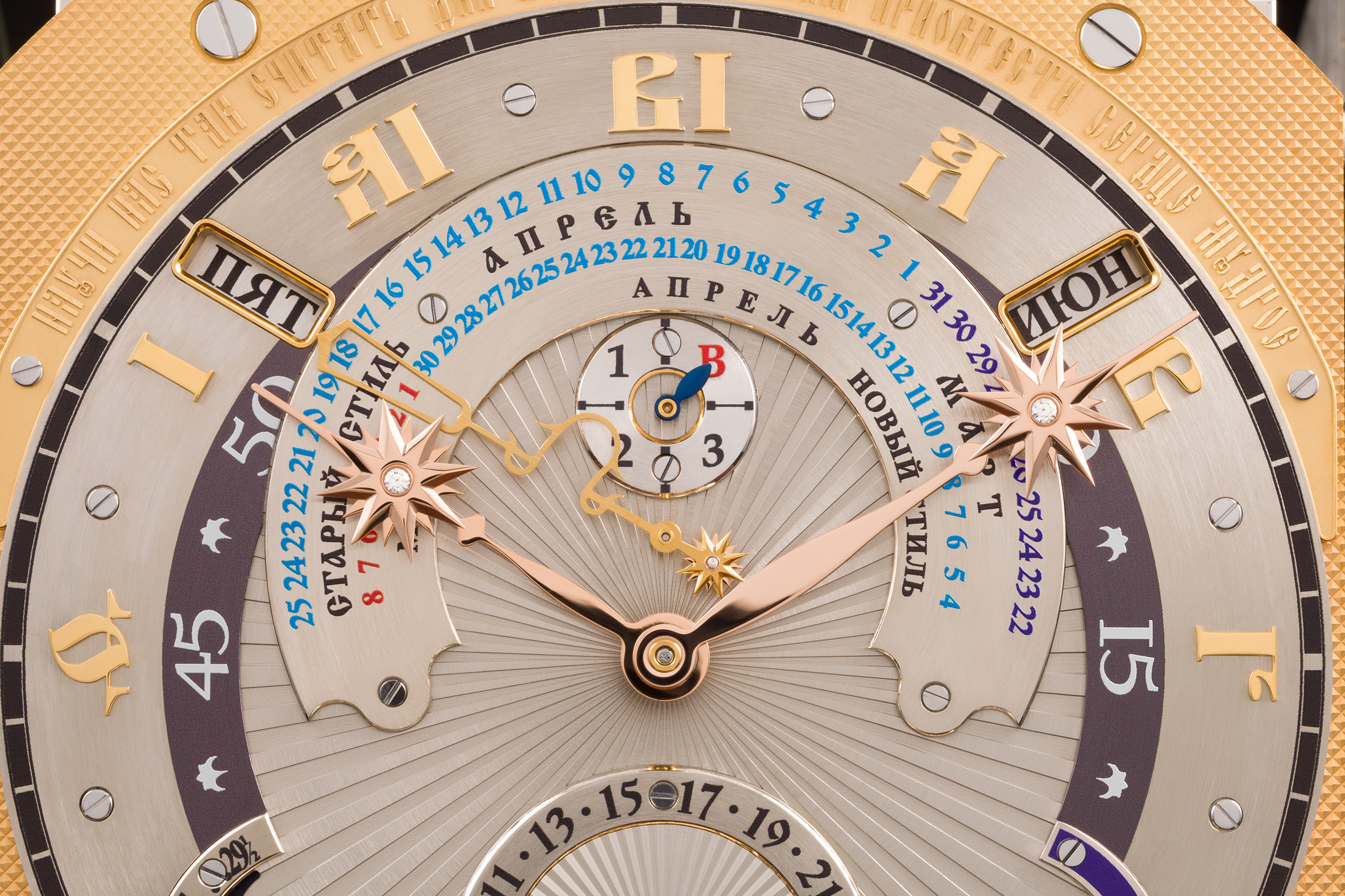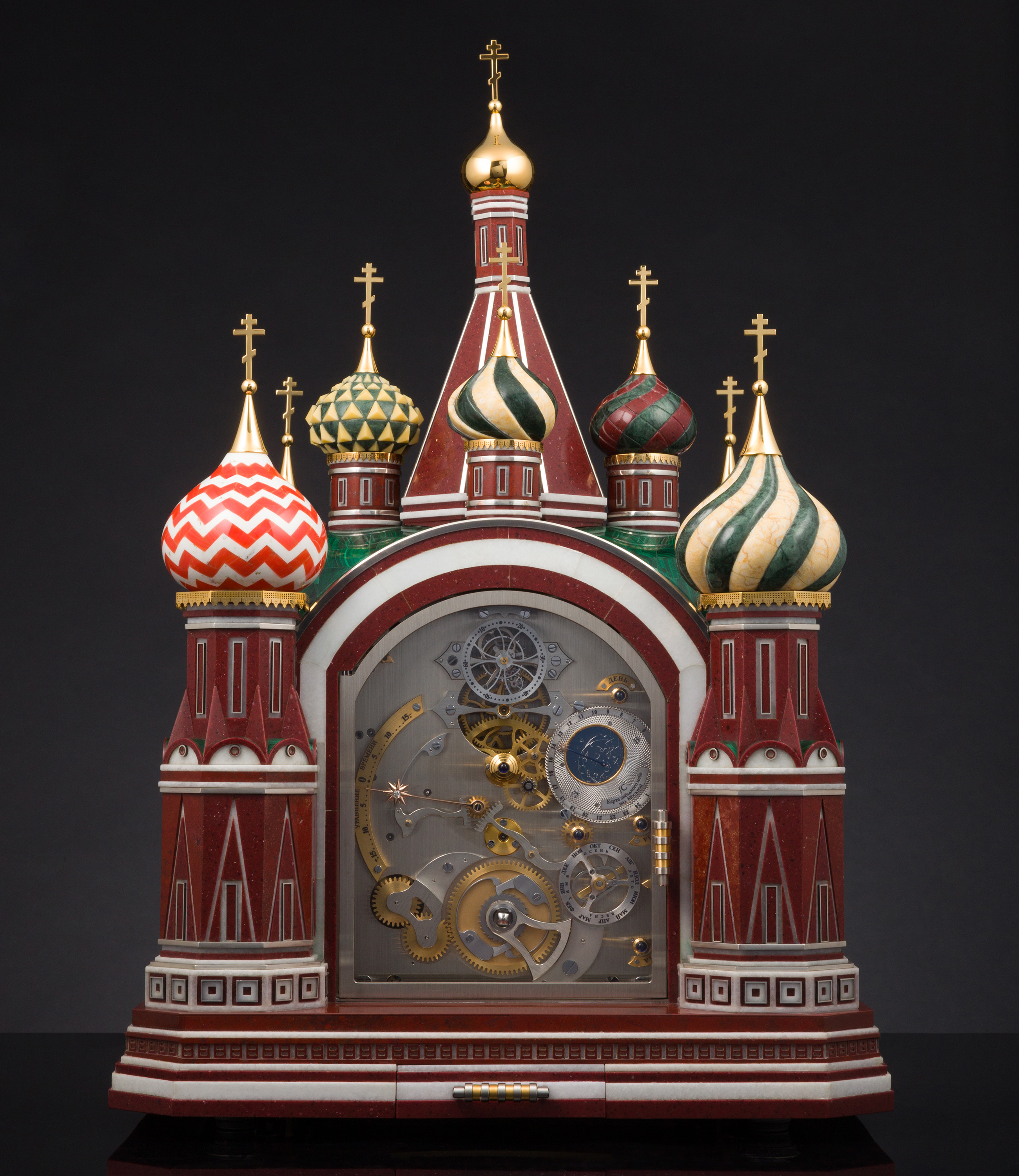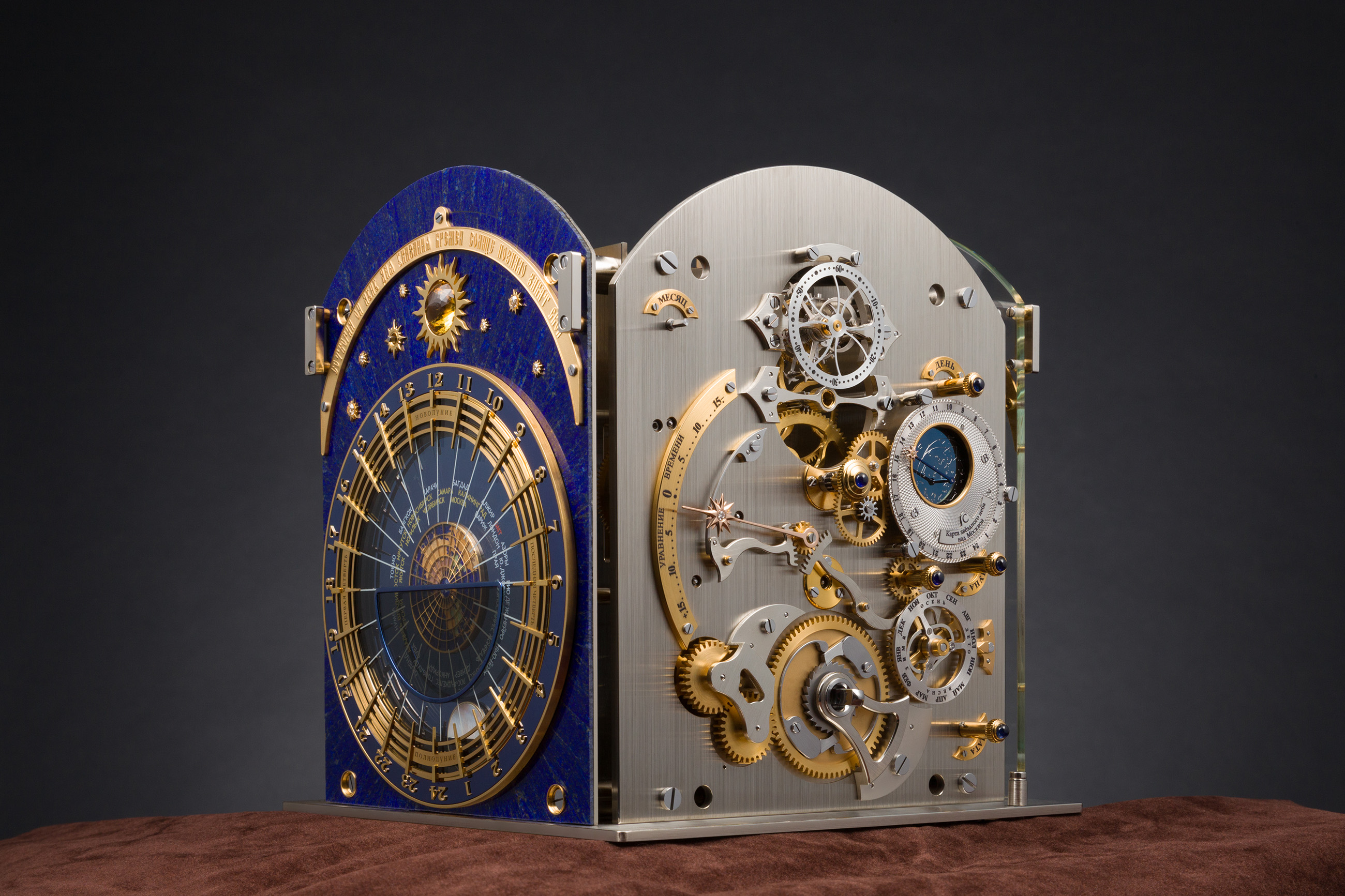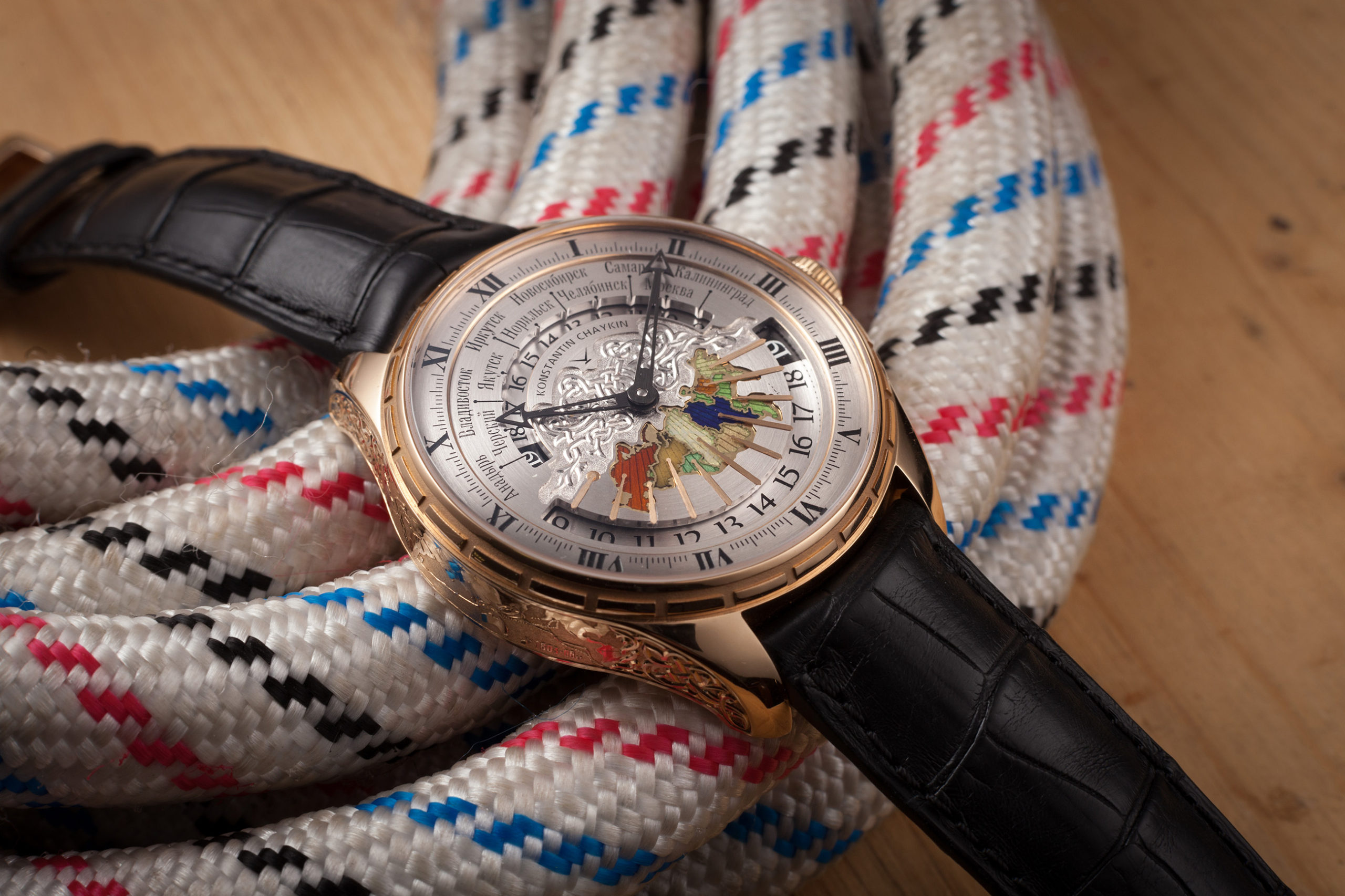The most complicated clock ever built in Russia
Russian inventor and independent watchmaker Konstantin Chaykin, member Academy of independent watchmakers (AHCI, Académie Horlogère des Créateurs Indépendants), presents in BaselWorld-2017 his latest masterpiece – supercomplication astronomical Moscow Computus Clock. To say that mechanics developed by Konstantin Chaykin is impressive – it is nothing to say. Movement of incredible complexity is composed of 2,506 parts, it has 4 dials and powers 26 complications and indications.
[wpvideo tKgoLQfL]
No clock of a comparable level of complexity was ever produced in Russia, it took no less than two years to create conception, develop and assemble movement and build artisanal semi precious stones case.

The complexity of Moscow Computus Clock is obvious: visually you will easily find indication of time in hours and minutes, Orthodox Easter date, perpetual calendar with 4-digits year indicator and power reserve indicator, orbital moon-phase indicator combined with worldtime function, unique analemma dial combined with indication of sunrise and sunset time in Moscow, and duration of day and night, dial with star-map in Moscow, sidereal time, equation of time, seasons and tourbillon used as small seconds hand. The movement runs for 10 days, it is equipped with special visual indication for last two days of power reserve. There is one more – hidden – treasure, the clock incorporates acoustical reminder of critically low level of power reserve. Special gong rings once every two minutes when there is just one day of power reserve left.

Just a bit of history
Computus complication – mechanism allowing automatic calculation of the date of Ester based on calendar, and moon-phase cycles – is the rarest and one of the most elaborated horological function. The list of watchmakers that had built clockwork equipped with Computus is extremely short list meaning seven or even eight centuries of mechanical horology development: Giovanni Dondi dell’Orologio (Italy), 14th century, who developed Computus for Astrarium, supercomplicated astronomical clock he made; Jean-Baptiste Schwilgué (France), 19th century, the author of the third astronomical clock of Strasbourg Cathedral; Auguste-Lucien Vérité (France), 19th century, who built astronomical clocks for St. Jean Cathedral in Besançon and Cathedral of Beauvais, both with Computus; Louis Zimmer (Belgium), Jens Olsen (Denmark), Frédéric Klinghammer (France) and Paul Pouvillon (France) created astronomical clocks with Computus in 20th century. Konstantin Chaykin had developed algorithm and automatic counting mechanism for Computus intended for display Orthodox Easter date, the first in the history of watchmaking, in 2007 (Resurrection clock), further developed for Northern Computus Clock in 2015 and now for Moscow Computus Clock.




So, what’s it, Moscow Computus Clock?
At first, we should accept that it is Orthodox Computus mechanism, the most complicated mechanical device designed just for one hand showing Easter date, and in fact the rest clockwork was build around it, even it represents the rest 25 functions of 26 in total. Computus mechanism alone takes no less than three hundred parts, including three stepped cams and differential gear calculated to perfectly operate until the year 9999, final year for Konstantin Chaykin’s algorithm, when additional adjustment will be necessary.

Computus mechanism sleeps throughout the year, and wakes up just ten minutes prior to the start of new year. It is one of the most astonishing horological function lasting couple of minutes of 525,600 minutes composing a year: Easter hand leaves Easter date of the previous year, goes deep to the left and then arises, slowly approaching Easter date of the new coming year. The mission is completed. But the story continues. There are 25 functions more, and surely one of the most spectacular is unique analemma dial. “I have been thinking about the analemma complication for 9 years”, notes Konstantin Chaykin. “For all these years, no matter what I had been working on, I kept the dream to incorporate intriguing astronomical phenomenon into clock. During 9 years, I invented several variations of analemma mechanism, and the most elegant technical solution I have decided to put into Moscow Computus Clock”. The analemma dial is really intriguing, it shows exact position of Sun in the sky if you will capture it in course of the year every day in the same moment if local time, i.e. at 12:00. This complication isn’t rare. In real it is unique because Konstantin Chaykin was the first who invented it and used for the first time in Moscow Computus Clock.
Finally we should mention one-minute tourbillon, properly set in clock in vertical position, very important part of the movement simply because Konstantin Chaykin had started with this complication his career in watchmaking art. The first tourbillon clock he built in 2004.
Artisanal appearance of Moscow Computus Clock
The supercomplicated movement of Moscow Computus Clock was set into nearly complicated artisanal case made with extensive use of semiprecious stones and composed of more than 2,500 parts carved from stone. The starting point of clock design was St Basil’s Cathedral, the pearl of Russian architecture and the world’s well known symbol of Moscow. The detailed work on the case of the clock took months of work of one of the best Russian artisan of stone mosaic. The case is covered with pieces of plenty of precious and semi-precious minerals and stones. Tricky stone setting technique means that artisan could elaborate just a few pieces of stone decoration a day, as every detail required six to seven finishing touches after each facet was perfectly formed and polished.


























… [Trackback]
[…] Info to that Topic: cronotempvscollectors.com/konstantin-chaykin-moscow-computus-clock/ […]
… [Trackback]
[…] Information on that Topic: cronotempvscollectors.com/konstantin-chaykin-moscow-computus-clock/ […]
… [Trackback]
[…] Read More Information here to that Topic: cronotempvscollectors.com/konstantin-chaykin-moscow-computus-clock/ […]
… [Trackback]
[…] Read More here to that Topic: cronotempvscollectors.com/konstantin-chaykin-moscow-computus-clock/ […]
… [Trackback]
[…] Information to that Topic: cronotempvscollectors.com/konstantin-chaykin-moscow-computus-clock/ […]
… [Trackback]
[…] Read More to that Topic: cronotempvscollectors.com/konstantin-chaykin-moscow-computus-clock/ […]